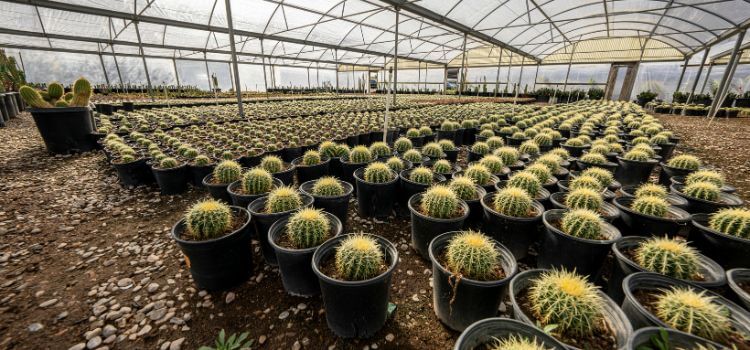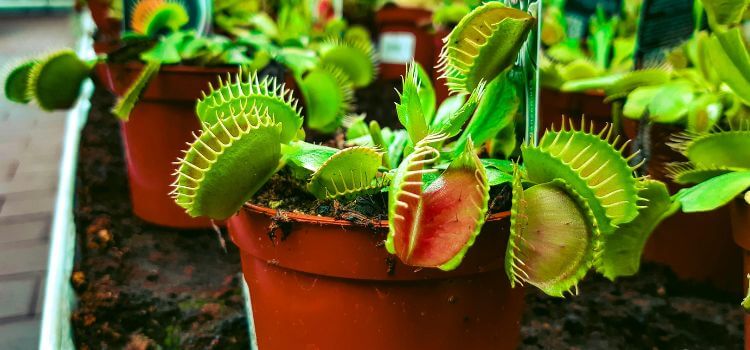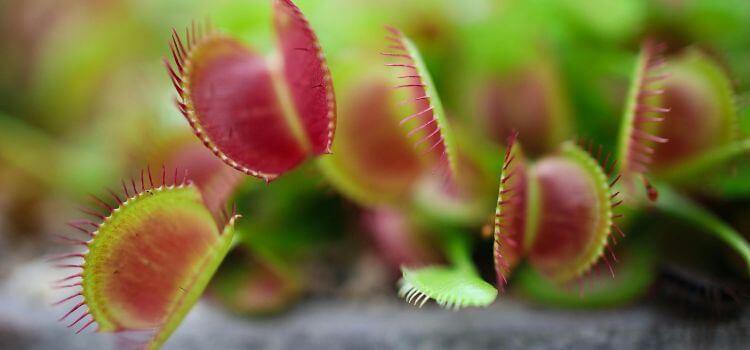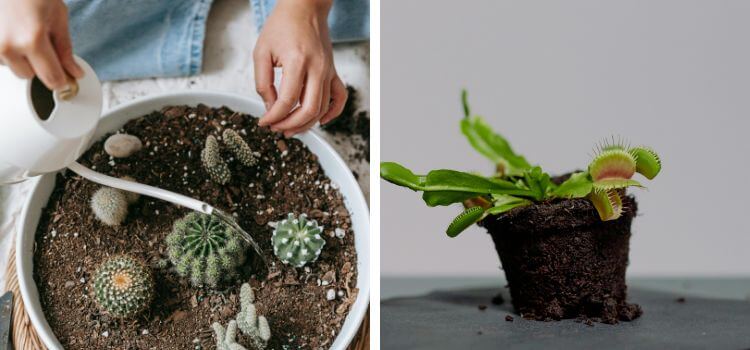As an Amazon Associate, I earn from qualifying purchases.
Cactus soil is not recommended for Venus fly traps. These carnivorous plants require a more acidic and less fertile medium.
The necessity for proper soil composition is crucial when cultivating a Venus fly trap, as it greatly impacts the health and growth of these unfamiliar plants. Originating from the subtropical wetlands of the United States, Venus fly traps have specific requirements to thrive, including well-draining, nutrient-poor soil with high acidity.
Using cactus soil, which is well-draining but nutrient-rich and more alkaline, could lead to poor plant health and inhibit the natural insect digestion process. Ensuring your Venus fly trap has the correct soil is essential for mimicking its natural habitat and ensuring its growth and robust carnivorous activity.

Cactus Soil
Cactus Soil begins with recognizing its unique mix. This soil caters to the needs of arid-loving plants, crafted to mimic their natural habitat. Cactus soil ensures these plants thrive indoors and outdoors.
Characteristics Of Cactus Soil
- Drainage – Water flows fast, preventing root rot.
- Aeration – Roots breathe easily, fostering growth.
- Texture – The soil is gritty, but it supports the proper root structure.
- pH Level – neutral to slightly acidic, ideal for cacti.
Benefits Of Cactus Soil
Cactus soil offers distinct advantages. Its composition favours plants that prefer less water. Here’s why it’s beneficial:
- Prevents Overwatering – Fast drainage keeps roots dry.
- Promotes Health – Proper aeration deters disease.
- Encourages Growth – With ideal conditions, roots strengthen.
Venus Fly Trap Soil Requirements
Finding the perfect soil for your Venus Fly Trap is a fascinating journey. These captivating carnivorous plants have unique needs that set them apart from your average houseplant. Understanding these requirements is key to maintaining their health and vitality.
Habitat Of Venus Fly Trap
In their natural habitat, Venus Fly Traps thrive in the bogs and wet savannahs of North and South Carolina. These environments, characterized by their wetness and nutrient-poor nature, are crucial for the plant’s survival. By replicating these conditions, we can ensure the health and longevity of our Venus Fly Traps, a responsibility we share as their caretakers.
Soil Composition For Venus Fly Trap
The soil of a Venus Fly Trap Trap should be nutrient-poor and well-draining. The ideal soil mix should contain something other than added trees or nutrients. Commercial cactus soil might seem like a good fit at first glance, but it contains added nutrients and minerals that are toxic to Venus Fly Traps.
Here’s what the soil mix should have:
- 1 part sphagnum peat moss
- 1 part perlite or silica sand
This Here’sation ensures proper drainage while still retaining enough moisture. It also mimics the plant’s natural acidic soil conditions. Avoid using regular potting soil, compost, or replanted mixes; these can harm your Venus Fly Trap.

Comparison With Cactus Soil
Understanding the needs of a Venus Fly Trap begins with evaluating its soil requirements. A comparison with cactus soil is essential to determine if one can use it to grow Venus Fly Traps.
Cactus Soil Vs. Venus Fly Trap Soil
These two soils have different qualities. Cactus soil drains quickly and contains more minerals, while Venus Fly Trap soil retains moisture and has low nutrients.
| Feature | Cactus Soil | Venus Fly Trap Soil |
|---|---|---|
| Drainage | Fast | Slow to Moderate |
| Organic Content | Low | High |
| Nutrient Levels | Higher | Lower |
| pH Level | Neutral to Alkaline | Acidic |
Suitability Of Cactus Soil For Venus Fly Trap
- Cactus soil is not suitable for Venus Fly Traps because it needs to meet moisture and nutrient requirements.
- Amending cactus soil with peat moss and perlite can help, but it could be better.
For best growth, use a specialized Venus Fly Trap soil mix instead of cactus soil.
Can I Use Cactus Soil For Venus Fly Trap?
Using cactus soil for Venus Fly Traps can be problematic due to their unique nutritional needs. Unlike cacti, which thrive in well-draining soil with rich nutrients, Venus Fly Traps require nutrient-poor, acidic environments to grow correctly. The high nutrient content in cactus soil can harm the plant by causing root burn or promoting the growth of unwanted bacteria and fungi.
A better alternative is to use a mix of sphagnum peat moss and perlite, which mimics the natural habitat of these carnivorous plants. This combination ensures proper aeration and moisture retention without the risk of nutrient overload.
Is Cactus Soil Good For Venus Fly Trap?
Cactus soil is not ideal for Venus fly traps. These unique plants thrive in nutrient-poor, acidic environments, typically found in their native bog habitats. Cactus soil often contains added nutrients and fertilizers that can harm Venus fly traps by burning their sensitive roots.
Instead, a mix of sphagnum peat moss and perlite or sand provides the right balance of acidity and drainage. Ensuring the soil remains moist but not soggy is crucial for the plant’s health. Using rainwater or distilled water to maintain appropriate moisture levels further supports their growth.
Regular monitoring of soil conditions helps prevent potential issues.
Adapting Cactus Soil For Venus Fly Trap
Thinking of planting a Venus Fly Trap in cactus soil? Cactus soil and Venus Fly Trap requirements are quite different. Yet, with the right alterations, you can make cactus soil work for your carnivorous plant.
Adjusting Ph Levels
Venus Fly Traps prefer acidic soil, unlike cactus soil, which is more neutral. Adjusting the pH is necessary. Here’s how:
- Mix sphagnum peat moss with cactus soil to increase acidity.
- Test the soil with a pH meter. Aim for a pH between 5.0 and 6.5.
- If it is too alkaline, add more peat or consider rainwater for irrigation.
Improving Moisture Retention
Cactus soil drains quickly. Venus Fly Traps need constant moisture. To improve water retention:
- Blend perlite into the cactus soil. It helps hold moisture while preventing root rot.
- Consider a layer of long-fibre sphagnum on top to keep moisture in.
- Use a tray with water to keep the environment humid.
Remember to avoid fertilizers and tap water. They can harm your Venus Fly Trap. Instead, create an ideal soil mix and use pure water for the best care!

FAQ on Can I Use Cactus Soil For Venus Fly Trap?
Venus flytraps thrive in nutrient-poor, acidic soil. A mix of peat moss and perlite or sand is ideal for proper drainage and growth.
No, cactus soil is not suitable for Venus flytraps. They require nutrient-poor, acidic soil, unlike the nutrient-rich substrate cacti need. Instead, use a mix of sphagnum peat moss and perlite.
Cactus soil is not recommended for pitcher plants; they require a more acidic, low-nutrient medium like sphagnum peat moss or a peat-sand mix.
Use a well-draining, nutrient-poor medium like a mix of peat moss and perlite or sand for Venus flytraps. Avoid enriched soils and fertilizers.
Carnivorous plants, including the Venus Fly Trap, require a specific type of soil to thrive. Cactus soil, while suitable for succulents, does not meet the unique needs of these fascinating plants.
Carnivorous plants grow in nutrient-poor, acidic environments and rely on a delicate balance of moisture and aeration. Using a soil mix specifically formulated for carnivorous plants, often a blend of sphagnum peat moss and perlite, ensures they receive the right conditions to thrive.
Conclusion
The right soil is critical for your Venus Fly Trap’s health. While cactus mix can serve in a pinch, it could be better. For best results, stick to a blend designed for carnivorous plants. Your fly trap will thank you with vigorous growth and robust traps ready to snatch their next meal.

